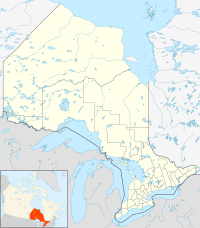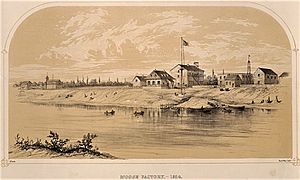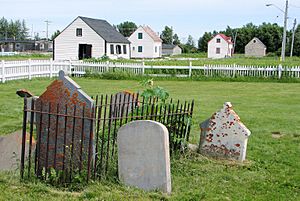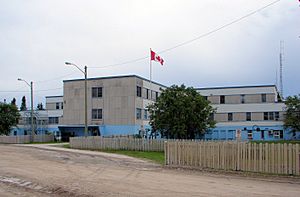Moose Factory facts for kids
Quick facts for kids
Moose Factory
|
|
|---|---|

St. Thomas' Anglican Church
|
|
| Nickname(s):
Moose Antlers
|
|
| Country | Canada |
| Province | Ontario |
| Region | Northeastern Ontario |
| District | Cochrane |
| Settled | 1673 |
| Renamed | 1686 |
| Government | |
| • Type | multiple governments |
| Area | |
| • Land | 5.25 km2 (2.03 sq mi) |
| Elevation | 7 m (23 ft) |
| Population
(2006)
|
|
| • Total | 2,458 |
| • Density | 473.3/km2 (1,226/sq mi) |
| Time zone | UTC−5 (EST) |
| • Summer (DST) | UTC−4 (EDT) |
| Postal code |
P0L 1W0
|
| Area code(s) | 705 |
Moose Factory is a community in Ontario, Canada. It's found on Moose Factory Island, which is close to where the Moose River meets James Bay. This place was the very first English-speaking settlement in what is now Ontario. It was also the second trading post set up by the Hudson's Bay Company (HBC) in North America.
Right across the Moose River, on the mainland, is the community of Moosonee. You can get to Moosonee by water taxi in summer or by ice road in winter. Helicopters are used when the ice is breaking up or freezing. There's also a ferry service that carries both people and vehicles across the river.
Most people living in Moose Factory are from the Cree First Nation. The hospital on the island, which serves the whole area, has a diverse group of workers. The word "Factory" in the name comes from the old term for a trading post run by a "factor." A factor was a business agent in charge of buying and selling goods for the Hudson's Bay Company.
Contents
Exploring the History of Moose Factory
Early Days and the Fur Trade
The area around Moose Factory was first explored in 1670-1671 by Pierre-Esprit Radisson, who worked for the Hudson's Bay Company. In 1673, the Hudson's Bay Company (HBC) set up a fur-trading post called Moose Fort. This fort was built on traditional lands of the Môsonîw Ililiw (Cree) people. The Cree played a big part in the fur trade, providing furs, supplies, and labor to the HBC for many years.
The fort was also built to protect the HBC's business from French traders who were active further south. Moose Fort became very successful and affected the fur trade in New France.
French Capture and British Return
Because the fort was so important, a group of French soldiers led by Chevalier de Troyes raided the HBC forts in 1686. The English defenders at Moose Fort were surprised and had to surrender. The French took over the fort and renamed it Fort St. Louis.
Ten years later, in 1696, the English recaptured the fort. They then burned it down, so no part of the original fort remains today. In 1713, the Treaty of Utrecht officially gave the fort back to the British. However, it took almost 20 years before the British returned to set up a new post.
A New Fort and Growing Community
In 1730, the Hudson's Bay Company built a new fort about a mile upstream from the old site. This new fort was made to help Cree traders who found it too dangerous to travel to other trading posts. Just five years later, this fort also burned down, but it was rebuilt over the next seven years.
By the early 1800s, Moose Factory became the main center for the HBC's southern operations. In 1821, the Hudson's Bay Company joined with its rival, the North West Company. With no more major threats, the trading post grew beyond its original walls. It then became known as Moose Factory and was the main base for the HBC in James Bay.
Modern Times and Changes
In 1905, the Cree signed a treaty (Treaty 9) with the government. This treaty created the Factory Island Indian Reserve. Around the same time, a French fur company called Revillon Frères opened a trading post across the river. This new post grew into the town of Moosonee and became a strong competitor to the HBC post in Moose Factory.
Moose Factory was quite isolated until 1931. That's when the Temiskaming and Northern Ontario Railway connected it to Moosonee. This meant supplies could arrive by train from the south, so the yearly sea voyages were no longer needed. The last supply ship arrived in 1936.
After World War II, the Hudson's Bay Company changed its focus to retail. In 1960, it opened a modern store in Moose Factory. Some of the old HBC buildings were turned into Centennial Park, an open-air museum that opened in 1967. The HBC continued to operate in Moose Factory until 1987, when its northern stores were sold to The North West Company. Today, The North West Company runs a grocery and general store in Moose Factory.
Climate
Moose Factory has a very cold climate. The weather data for the area comes from Moosonee, which is about 3 kilometers to the west.
| Climate data for Moosonee (Moosonee Upper Air (UA)) WMO ID: 71836; coordinates 51°16′N 80°39′W / 51.267°N 80.650°W; elevation: 10.0 m (32.8 ft); 1991–2020 normals, extremes 1877–present |
|||||||||||||
|---|---|---|---|---|---|---|---|---|---|---|---|---|---|
| Month | Jan | Feb | Mar | Apr | May | Jun | Jul | Aug | Sep | Oct | Nov | Dec | Year |
| Record high humidex | 5.7 | 8.0 | 26.0 | 27.7 | 40.3 | 46.0 | 45.5 | 41.3 | 38.3 | 32.3 | 22.5 | 10.6 | 46.0 |
| Record high °C (°F) | 7.2 (45.0) |
10.6 (51.1) |
24.5 (76.1) |
27.9 (82.2) |
34.2 (93.6) |
37.1 (98.8) |
37.8 (100.0) |
35.0 (95.0) |
36.3 (97.3) |
28.1 (82.6) |
20.5 (68.9) |
13.2 (55.8) |
37.8 (100.0) |
| Mean daily maximum °C (°F) | −13.0 (8.6) |
−10.8 (12.6) |
−4.0 (24.8) |
3.8 (38.8) |
12.7 (54.9) |
19.8 (67.6) |
22.9 (73.2) |
21.6 (70.9) |
16.9 (62.4) |
8.9 (48.0) |
0.1 (32.2) |
−8.8 (16.2) |
5.8 (42.4) |
| Daily mean °C (°F) | −18.7 (−1.7) |
−17.4 (0.7) |
−11.0 (12.2) |
−2.2 (28.0) |
6.4 (43.5) |
12.7 (54.9) |
16.3 (61.3) |
15.5 (59.9) |
11.3 (52.3) |
4.9 (40.8) |
−3.6 (25.5) |
−13.5 (7.7) |
0.1 (32.2) |
| Mean daily minimum °C (°F) | −24.4 (−11.9) |
−23.9 (−11.0) |
−18.0 (−0.4) |
−8.1 (17.4) |
0.1 (32.2) |
5.7 (42.3) |
9.8 (49.6) |
9.4 (48.9) |
5.8 (42.4) |
0.6 (33.1) |
−7.5 (18.5) |
−18.2 (−0.8) |
−5.7 (21.7) |
| Record low °C (°F) | −48.9 (−56.0) |
−47.8 (−54.0) |
−44.4 (−47.9) |
−33.9 (−29.0) |
−17.8 (0.0) |
−7.0 (19.4) |
−2.2 (28.0) |
−3.1 (26.4) |
−6.1 (21.0) |
−16.7 (1.9) |
−34.4 (−29.9) |
−44.4 (−47.9) |
−48.9 (−56.0) |
| Record low wind chill | −51.0 | −55.6 | −49.6 | −39.0 | −14.4 | −8.5 | −2.5 | −5.0 | −8.0 | −18.3 | −39.9 | −50.0 | −55.6 |
| Average precipitation mm (inches) | 33.0 (1.30) |
28.6 (1.13) |
35.3 (1.39) |
38.1 (1.50) |
54.6 (2.15) |
71.7 (2.82) |
96.8 (3.81) |
77.8 (3.06) |
95.3 (3.75) |
74.7 (2.94) |
56.3 (2.22) |
41.5 (1.63) |
703.6 (27.70) |
| Average rainfall mm (inches) | 0.1 (0.00) |
1.8 (0.07) |
6.5 (0.26) |
21.0 (0.83) |
47.7 (1.88) |
71.5 (2.81) |
96.8 (3.81) |
77.8 (3.06) |
94.6 (3.72) |
62.1 (2.44) |
19.1 (0.75) |
3.5 (0.14) |
502.6 (19.79) |
| Average snowfall cm (inches) | 39.9 (15.7) |
31.7 (12.5) |
31.0 (12.2) |
17.9 (7.0) |
6.6 (2.6) |
0.2 (0.1) |
0.0 (0.0) |
0.0 (0.0) |
0.6 (0.2) |
13.2 (5.2) |
40.6 (16.0) |
45.2 (17.8) |
226.8 (89.3) |
| Average precipitation days (≥ 0.2 mm) | 14.8 | 11.3 | 10.9 | 10.2 | 12.5 | 13.9 | 16.4 | 15.2 | 18.5 | 16.5 | 15.7 | 15.9 | 171.7 |
| Average rainy days (≥ 0.2 mm) | 0.23 | 0.95 | 2.2 | 5.1 | 10.8 | 13.8 | 16.4 | 15.2 | 18.5 | 13.4 | 4.8 | 1.1 | 102.3 |
| Average snowy days (≥ 0.2 cm) | 15.0 | 11.0 | 10.1 | 6.7 | 3.1 | 0.17 | 0.0 | 0.0 | 0.09 | 5.0 | 13.1 | 15.6 | 79.7 |
| Average relative humidity (%) (at 1500 LST) | 71.9 | 64.9 | 59.5 | 59.7 | 60.7 | 59.1 | 61.6 | 63.6 | 65.3 | 69.3 | 76.1 | 77.9 | 65.8 |
| Mean monthly sunshine hours | 93.6 | 128.7 | 161.6 | 192.0 | 221.2 | 213.5 | 249.2 | 219.7 | 134.8 | 88.5 | 52.9 | 55.2 | 1,810.7 |
| Percent possible sunshine | 35.8 | 45.7 | 44.0 | 46.3 | 45.9 | 43.1 | 50.0 | 48.6 | 35.4 | 26.6 | 19.7 | 22.3 | 38.6 |
| Source: Environment and Climate Change Canada (rain/rain days, snow/snow days, precipitation/precipitation days and sun 1981–2010) | |||||||||||||
Economy and Daily Life
How People Make a Living
The main ways people earn money in Moose Factory are through healthcare, services, tourism, and construction. The biggest employer is the Weeneebayko General Hospital. Other important employers include the Moose Cree First Nation and Northern Stores.
The main stores on the island are Northern Stores, G.G.'s, and QuickStop. "The Complex" is a community center that has a grocery store (Northern Stores), a restaurant, a Canada Post office, a pharmacy, and other offices.
Traditional Skills and Crafts
While most people don't live only off the land anymore, many still take part in the spring and fall moose hunt. Traditional skills are still practiced, like preparing moose hides and making moccasins and mitts with beautiful beadwork. Other crafts made in Moose Factory include tamarack geese, snowshoes, and soapstone carvings. These items are sold locally.
Fun Things to Do and See
Exploring Attractions and Tours
Moose Factory has many interesting places to visit. These include Centennial Park, which has old buildings from the Hudson's Bay Company, and the Cree Cultural Interpretive Centre. You can also visit the Cree Village Eco Lodge and St. Thomas' Anglican Church.
In both summer and winter, you can go on outdoor tours. These include trap-line tours, canoe trips, and snowmobile adventures. Tidewater Provincial Park is also nearby. Visitors can take boat tours down the Moose River to James Bay or upstream to Fossil Island.
The Polar Bear Express Train
Many people recommend taking the Polar Bear Express train. This train travels between Cochrane, Ontario and Moosonee. On the journey, you can see hydroelectric dams, isolated homes, and maybe even some wildlife! The train is run by Ontario Northland and carries both passengers and cargo. You can buy tickets in Cochrane, Moosonee, Moose Factory, and Timmins. The train will even stop in some places if you signal it to. It runs six days a week in summer and five days a week during other seasons.
Cree Cultural Interpretive Centre
The Cree Cultural Interpretive Centre is a great place to learn about Cree culture and see traditional crafts. It shows many different parts of the Cree way of life.
Cree Eco Lodge
The Cree Village Eco Lodge is a special place to stay that focuses on being friendly to the environment. It opened in 2000 and has modern rooms and a restaurant. You can even try traditional bannock (a type of bread) and goose (when it's in season) cooked in a teepee next to the lodge. From the lodge, you can see Sawpit Island and Charles Island.
You can also take boat rides from the lodge out to James Bay or go on fishing and canoeing trips to the Moose River Migratory Bird Sanctuary.
Centennial Park: A Walk Through History
Centennial Park is home to the Moose Factory Buildings National Historic Site of Canada. These buildings were part of the old Hudson's Bay Company post. The Staff House, built in 1847-1850, is still in its original spot. It's the oldest building in the James Bay area and the last remaining home for a fur trade officer in Canada. The Powder Magazine, built in 1865-1866, is also in its original location within the park.
These 19th-century buildings were recognized as a National Historic Site of Canada in 1957.
The Moose Factory Hudson's Bay Company staff house was once where HBC doctors, captains, and clerks lived. Today, it's a museum and tourism office. It's a very old and important building, recognized by the Ontario Heritage Trust.
In the Hudson's Bay Company cemetery, the oldest gravestone is from 1802. It marks the grave of the Cree wife and children of John Thomas, who was in charge of the post. There are 51 gravestones in total. Most British men would return home after their work was done, so there are only a few graves of British men here.
The Joseph Turner House is the oldest known surviving servant house of the HBC, built in 1863. It was named after Joseph Turner, an HBC trader. The William McLeod House was built in 1889-1890 by HBC carpenter William McLeod. It was once home to his family.
The Ham Sackabuckiskum House is the only surviving Cree summer home. It was built in 1926 by the HBC to encourage loyalty from Cree trappers. It was the home of Sackabuckiskum, a Cree fur-trapper.
The blacksmith shop, built in 1849, is the last known surviving HBC blacksmith shop. It was used until 1934. The powder magazine is the only stone building, built in 1865. It was used to store gunpowder but later became a general storage building.
St. Thomas' Anglican Church
St. Thomas' Anglican Church is a historic church built by the Hudson's Bay Company. It has a unique Carpenter Gothic style. Building started in 1864 and was finished in 1885.
Healthcare Services
In 1949, the Moose Factory General Hospital was built. It was originally a special hospital for patients with tuberculosis, a serious lung disease. It helped both First Nations and Inuit patients.
Today, the Weeneebayko General Hospital provides medical care to people in Moose Factory, Moosonee, and other nearby communities like Fort Albany, Ontario, Attawapiskat First Nation, Kashechewan First Nation, and Peawanuck First Nation. The hospital has doctors, surgeons, and other medical staff. They also work with larger hospitals in cities like Kingston, Toronto, and Timmins for more specialized care.
The hospital offers many services, including:
- 24-hour emergency care
- Family doctor clinics
- Dentistry
- General surgery
- Dialysis
- A traditional healing program with counsellors and traditional healers
- Diabetes education
- Regular visits from specialists in areas like pediatrics and eye care
- Imaging services like X-rays and ultrasounds
- Lab services
Patients who need special tests or care in other cities are flown there by chartered planes. Many medical students from Queen's University and other universities also come to the hospital for training.
Education
Moose Factory has three schools for students:
- Ministik Public School is an elementary school for Junior Kindergarten to Grade 8.
- Delores D. Echum Composite School is a school for Grades 7 to 12.
- Moose Factory Academy of Christian Education is a private elementary school.
Some college programs are available through Northern College. These can be taken through online courses or video lessons. The James Bay Education Centre helps connect students with these programs.
Moose Factory also had a residential school called Bishop Horden Memorial School (also known as Horden Hall Residential School). It was run by the Anglican Church from 1907 to 1963 and served children from the James Bay area.
Famous People from Moose Factory
- Jonathan Cheechoo is a former professional Ice hockey player who played in the NHL.
- Shirley Cheechoo is an actress, writer, producer, director, and visual artist who grew up in Moose Factory.
- Duane Linklater is a sculptor who was born in Moose Factory.









